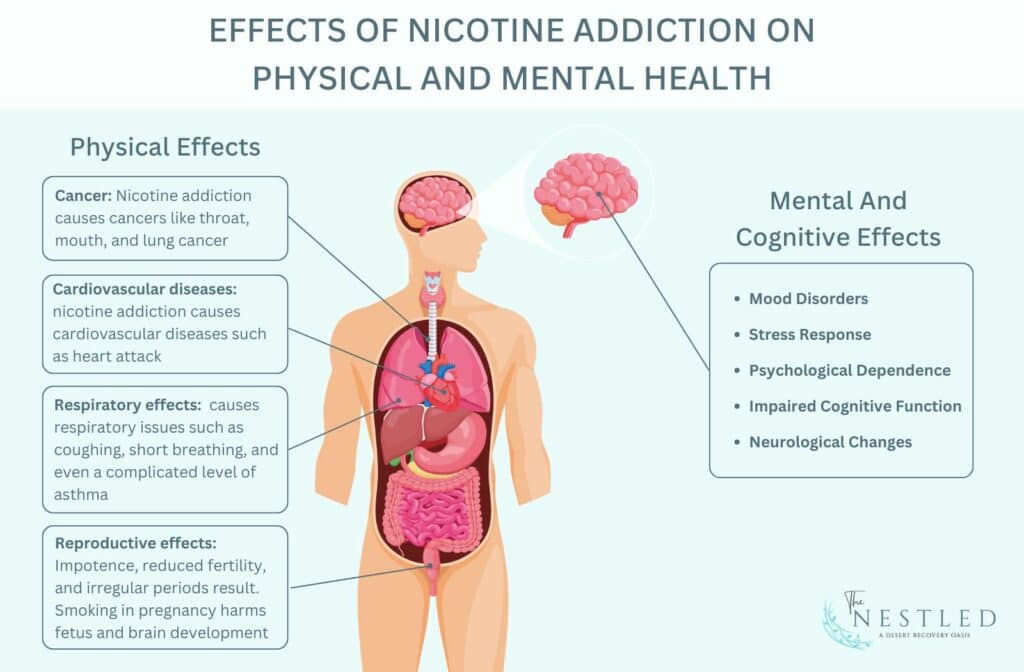Nicotine addiction is an uncontrolled consumption of nicotine, a stimulant found in tobacco products such as cigarettes and cigars. Nicotine stimulates the release of neurotransmitters such as dopamine and norepinephrine, thus enhancing mood and concentration. This reward mechanism makes smoking and other forms of tobacco use addictive. The National Institute on Drug Abuse found approximately 23.6 million Americans have a nicotine use disorder.
Signs of nicotine addiction are cravings for the drug, failed attempts to quit using it, and withdrawal symptoms like irritability, anxiety, and restlessness. Avoiding gatherings or places where smoking or vaping is not allowed is also a sign of nicotine dependence.
The treatment options available for nicotine addiction are prescription medication, nicotine replacement therapy, and family or support groups.
Prevention strategies for nicotine addiction include implementing policies that restrict the sale of tobacco products to minors. Establishing smoke-free environments in public places will reduce exposure to secondhand smoke and decrease the social acceptability of smoking.
What Is Nicotine Addiction?
Nicotine addiction is a condition associated with a compulsive or excessive need to use nicotine-containing products despite the health risks and complications they usually cause. It occurs when an individual needs nicotine or any tobacco product to feel normal or relieved.
When nicotine enters the body through smoke chewing or injection, it triggers the reward aspect of the brain and increases the dopamine rush at that moment. This sensation is, however, temporary; so, to feel that form of sensation again, you need another amount of nicotine. The more you use nicotine products, the more you need to feel good, making it difficult to quit.
Trying to quit will then lead to some unpleasant physical and mental symptoms of withdrawal. The National Institute on Drug Abuse (NIDA) reports that regular nicotine users may experience irritability, cravings, depression, anxiety, cognitive and attention deficits, sleep disturbances, and increased appetite if they go without nicotine for a long time. These withdrawal symptoms can start just a few hours after the last cigarette, often compelling individuals to return to tobacco use.
What Are The Signs Of Nicotine Addiction?
Signs of nicotine addiction are:
- Craving for nicotine
- Mood swings
- Sadness and anxiety
- Irritability
- Withdrawal symptoms like restlessness and difficulty sleeping.
- Dependence
- Continued use despite health risks
What Causes Nicotine Addiction?
The causes of nicotine addiction are its effect on neurotransmitters, its availability, psychological factors, genetic factors, as well as social and environmental influences.
- Effects on Neurotransmitters: The primary cause of nicotine addiction is the addictive compound of the substance itself. Once nicotine enters the body, it releases or increases the level of neurotransmitters that are in charge of mood, behavior, and reward. One of the neurotransmitters that nicotine releases is dopamine. The dopamine gives nicotine users a sensation of relief, and that is what every individual addicted to nicotine craves: the dopamine rush every time.
- Availability: According to the U.S. Centers for Disease Control and Prevention, 2021, the availability of nicotine-containing items like cigarettes and e-cigarettes plays a significant role in the high rates of nicotine addiction.
- Psychological factors: According to Khantzian’s 1997 study, psychological factors such as stress, low self-esteem, depression, anxiety, and coping mechanisms contribute to nicotine addiction. Several individuals use nicotine to manage emotions, relieve stress, or cope with mental health issues.
- Social and Environmental Influences: Peer influence, family history of tobacco use, exposure to tobacco products, and cultural norms are crucial causes of nicotine addiction.
- Genetic Factors: Variations in genes related to nicotine metabolism, receptors, and dopamine pathways increase the susceptibility to nicotine addiction.
What Are The Physical Health Effects Of Nicotine Addiction?
According to the Mayo Clinic, nicotine addiction causes health problems like lung cancer and lung disease, diabetes and heart and circulatory system problems.
- Cardiovascular diseases: nicotine addiction causes cardiovascular diseases such as heart attack.
- Cancer: nicotine addiction causes cancers such as throat cancer, mouth cancer, lung cancer, and so on.
- Reproductive effects: Nicotine addiction causes reproductive issues such as erectile dysfunction, reduced fertility, and menstrual irregularities. Pregnant women smoking exposes the child to harmful chemicals which alter fetal growth and even brain development.
- Respiratory effects: Nicotine addiction causes respiratory issues such as coughing, short breathing, and even a complicated level of asthma.

What Are The Mental And Cognitive Effects Of Nicotine Addiction?
The mental effects and cognitive effects of nicotine addiction are mood disorders, stress response, psychological dependence, impaired cognitive function, and neurological changes.
In their 2007 research, ‘Smoking as a risk factor for dementia and cognitive decline: a meta-analysis of prospective studies,’ Anstey KJ et al, report that long-term smoking is associated with cognitive decline and risk of Alzheimer’s Disease.
- Mood Disorders: Nicotine users can experience mood swings, irritability, and increased susceptibility to stress when they withdraw from it. Furthermore, nicotine addiction is associated with an increased risk of developing depression and anxiety disorders.
- Stress Response: In the long term, nicotine addiction increases stress levels. When the body craves nicotine but doesn’t receive it, stress levels increase, creating a vicious cycle of dependency.
- Psychological Dependence: Smoking or vaping, over time, becomes a psychological crutch that people rely on to cope with anxiety, stress, boredom, or even social situations.
- Impaired Cognitive Function: Chronic nicotine exposure has been linked to an increased risk of cognitive decline. Riaz Tuba et al.’s 2021 study conducted in Pakistan showed that young cigarette smokers experienced significant impairment in cognitive function compared to nonsmokers.
- Neurological Changes: Nicotine alters the way neurotransmitters are released and used in the brain, which changes brain structure and function over time.
What Are The Behavioral Effects Of Nicotine Addiction?
The behavioral effects of nicotine addiction are:
- Persistent desire or urge to use nicotine-containing products.
- Inability to control nicotine intake despite awareness of negative consequences.
- Increased tolerance
- Spending so much time obtaining, using, or recovering from nicotine use, often at the expense of other activities and responsibilities.
- Changes in social behavior, such as preferring nicotine-related activities over social interactions and strained relationships due to nicotine use.
- Engaging in risky activities to obtain nicotine, such as driving while smoking or using e-cigarettes in prohibited areas.
- Difficulty abstaining from nicotine despite previous attempts to quit, often due to the reinforcing nature of nicotine addiction and environmental triggers.
What Are The Effects Of Nicotine On The Brain?
The Mayo Clinic explains that nicotine produces pleasing effects in the brain, but these effects are temporary. This pleasing effect is what makes users continue consuming the substance, to the point of physical and psychological dependence.
Nicotine affects the brain in four ways: stimulation of neurotransmitter release, reward pathway activation, change in brain structure, and development of tolerance.
- Stimulation of Neurotransmitter Release: Nicotine binds to nicotinic acetylcholine receptors in the brain, leading to increased release of neurotransmitters such as dopamine, norepinephrine, serotonin, and glutamate. This results in feelings of pleasure, improved mood, and enhanced cognitive function.
- Reward Pathway Activation: Nicotine activates the brain’s reward pathway, reinforcing the behavior of nicotine use and contributing to addiction.
- Changes in Brain Structure and Function: Chronic nicotine exposure leads to alterations in brain structure and function, including changes in synaptic plasticity, neurotransmitter systems, and neural circuitry involved in reward, learning, and decision-making.
- Development of Tolerance: Continued nicotine use leads to the development of tolerance, requiring higher doses of nicotine to achieve the same effects over time.
- Nicotine Withdrawal: When nicotine levels decrease, withdrawal symptoms occur due to changes in neurotransmitter activity, leading to cravings, irritability, anxiety, and other symptoms.
- Increased Vulnerability to Other Substances: Nicotine use increases the brain’s sensitivity to the effects of other drugs, potentially leading to polysubstance abuse.
- Risk of Dependence and Addiction: The reinforcing effects of nicotine on the brain’s reward system lead to dependence and addiction, characterized by compulsive drug-seeking behavior despite negative consequences.
What Are The Statistic Prevalence Of Nicotine Addiction?
- The lifetime prevalence of nicotine dependence was 24%, nearly half of those who had ever smoked daily for a month or more.
- According to the U.S Department of Health and Human Services, tobacco smoking causes about half a million U.S. deaths annually, of which 50,000 are among nonsmokers exposed to secondhand smoke.
- The American Lung Association estimates that 35% of cigarette smokers have a behavioral health disorder and account for 38% of all U.S. adult cigarette consumption, according to data from the National Health Interview Survey, 2017.
What Are The Treatment Options For Nicotine Addiction?
The National Institute on Drug Abuse, NIDA, cites behavioral treatments like Cognitive Behavioural Therapy, Motivational Interviewing and mindfulness as treatment approaches to nicotine addiction.
In a 2019 study titled “Current advances in research in treatment and recovery: Nicotine addiction,” Judith J. Prochaska and Neal L. Benowitz report that medications for nicotine addiction help smokers feel more comfortable as they learn to manage daily cues, triggers, and life stressors without resorting to cigarette smoking.
The 3 treatment options available for nicotine addiction are prescription medications, NRT, and therapies.
1. Prescription Medications
Treating nicotine involves using medications to manage withdrawal symptoms during the detox phase. These medications control the part of the brain responsible for cravings. Effective medications include varenicline and bupropion.
2. Nicotine Replacement Therapy (NRT)
This is called nicotine replacement therapy. The options include patches, gums, nasal sprays, or inhalers. These options contain nicotine too, but without the compounds found in tobacco, hence they don’t get users high or addicted. They help users quit using slowly and methodologically.
Another option is the non-nicotine anti-depressants; they improve dopamine levels and mood. Treating any underlying mental health issue increases the chances of recovery from nicotine addiction.
3. Psychological Approach
The psychological treatment approach for nicotine addiction includes counseling and support groups. Support groups are essential on the journey to quitting nicotine consumption. Whether virtual or in-person, a support group helps you learn coping skills and makes the journey easier as you interact with others facing the same challenge and striving to quit.
The following are some tips that make quitting nicotine addiction journey easier;
- Regular exercise
- Snacking
- Getting rid of tobacco products in your home or car
- Avoid triggers like settings where other smokers are present
- Healthy eating
Other remedies and natural alternatives for nicotine addiction treatment include hypnosis, herbs, essential oils, and acupuncture. However, there is no confirmation of the effectiveness and safety of these options yet.
What Are The Prevention Strategies For Nicotine Addiction?
The prevention strategies for nicotine addiction are education, regulations, community engagement, and access restrictions. The essence of nicotine addiction prevention strategies is to the initiation of tobacco use and discourage tobacco consumption among every age and social group.
1. Youth education and awareness
Educating youths and various age groups about the health complications of nicotine and the benefits of living a tobacco-free lifestyle is one of the most effective ways to prevent addictions. Also, youth involvement in anti-tobacco movements and initiatives to raise awareness about the health risks of nicotine is another preventive strategy.
2. Nicotine-free policies
Implementing nicotine-free regulations in schools, health centers, and public places will reduce the consumption of that substance. The regulation should include a fine or punishment for anyone who goes against it.
3. Community engagement
Collaborate with community leaders, local governments, and even businesses to organize nicotine prevention programs, resources, and support services. Create and run media campaigns using the media to raise awareness of the health risks of nicotine and why it is beneficial to live a tobacco-free lifestyle.
4. Price and access restrictions
Availability and affordability are some of the reasons people get addicted to nicotine. Tobacco tax implementation and price inflation will reduce how much people purchase and use tobacco. Also, there should be age verification before tobacco is sold to anyone. This will prevent minors from having access to it.
Where To Find Treatment For Nicotine Addiction?
Treatment for tobacco addiction is available in various settings, such as rehabilitation centers, outpatient programs, and smoking cessation clinics. Support groups like Nicotine Anonymous also offer assistance.
How To Treat Nicotine Overdose
In a medical facility, activated charcoal is used to treat nicotine overdose if detected early. This charcoal helps absorb nicotine that the body has not yet absorbed. To control seizures, heart rate, and blood pressure, additional drugs are administered.
What Are The Different Forms Of Nicotine?
Nicotine comes in various forms, including cigarettes, cigars, pipe tobacco, chewing tobacco, and snuff.
What Are The Different Slang Names For Nicotine?
Slang names for nicotine include cigs, smokes, butts, and chew.
How does nicotine addiction compare to inhalant addiction in terms of health risks and treatment options?
Nicotine addiction and inhalant addiction both pose significant health risks, but they affect the body in different ways. Nicotine addiction primarily impacts cardiovascular health, increasing the risk of heart disease, stroke, and respiratory issues such as chronic obstructive pulmonary disease (COPD). Treatment options for nicotine addiction include nicotine replacement therapies (NRTs), prescription medications like varenicline and bupropion, and behavioral therapies. Inhalant addiction, on the other hand, can cause severe damage to the brain, liver, kidneys, and lungs, and can lead to sudden death due to heart failure or asphyxiation. Treatment for inhalant addiction often involves detoxification, behavioral therapies, and supportive care to manage withdrawal symptoms and address any long-term health effects.
Where And How Is Nicotine Typically Manufactured And Produced?
Nicotine is cultivated in fields and processed in manufacturing facilities. It is often sold in various forms, including cigarettes, cigars, and smokeless nicotine products.
What Are The Law Enforcement Efforts And Legal Implications Of Nicotine?
Law enforcement enforces regulations on nicotine sales to minors, taxation, and restrictions on smoking in public places. Legal implications for violating nicotine laws include fines and penalties.
What Is The Role Of Law Enforcement Agencies In Stopping Nicotine Distribution And Use?
Law enforcement agencies enforce nicotine control policies, conduct sting operations to prevent illegal sales and educate the public about the risks of nicotine use.
How do public health strategies differ in addressing nicotine addiction versus Percocet addiction?
Public health strategies for addressing nicotine addiction often focus on prevention through education, smoking cessation programs, and policies that restrict tobacco advertising and sales. These strategies include public awareness campaigns about the health risks of smoking, increasing taxes on tobacco products, and providing resources such as quitlines and support groups to help individuals stop smoking. In contrast, public health strategies for Percocet addiction typically involve measures to control the prescribing and distribution of opioids, as well as efforts to educate the public and healthcare providers about the risks of opioid use. These strategies include implementing prescription drug monitoring programs (PDMPs), promoting safe prescribing practices, increasing access to addiction treatment services, and distributing naloxone to reverse opioid overdoses.
What Are The Drug Control Policies And Implications For Nicotine?
Various laws and policies regulate nicotine, including taxation, advertising restrictions, and smoke-free laws, with the goal of reducing its use and promoting public health.
What Are The Legal Consequences Of Using And Selling Nicotine?
Legal consequences for violating nicotine laws include fines, penalties, and restrictions on tobacco sales licenses.
How Are The Effects Of Nicotine Addiction And Other Drug Addiction Different Or Similar?
Nicotine addiction is primarily characterized by physical dependence on nicotine, whereas other drug addictions involve dependence on different substances with varying effects. However, both nicotine addiction and other drug addictions lead to negative health outcomes and social consequences.

Share This Post




